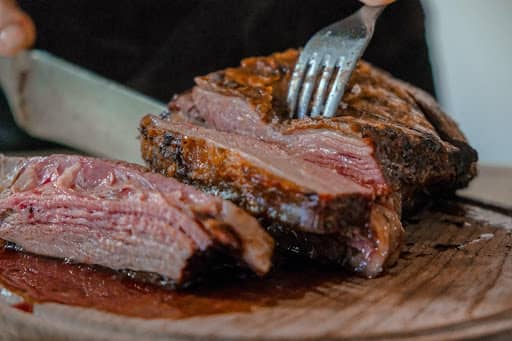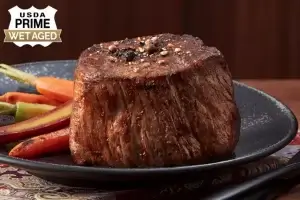
Have you ever picked up a beef roast — or chicken or pork, for that matter — from the grocery store or a local butcher that’s been tied with string both lengthwise and widthwise? If so, you’ve found a trussed piece of meat, which is just a fancy way of saying it’s been tied with string.
You might wonder why some meat comes tied and others don’t. You might also notice that it usually is roasts and bigger cuts of beef that get trussed. What gives?
This beef roast trussing guide gives all the details, including explaining what trussing is, why it’s important, and how to do it yourself.
What Is Beef Trussing?
Beef trussing is a technique that ties string snugly on a roast. The strings run the length and width of the meat, holding it all together in a tidy little package. The string used is a type of twine that’s soft and highly pliable, allowing it to wrap around meat and hold it together tightly.
Trussing happens most often on beef and pork, especially with larger cuts and roasts. However, you’ll sometimes see trussing on chicken or fish, depending on the butcher’s preferences and the size of the meat. Essentially, trussing keeps the meat held together, which is helpful for oddly-shaped cuts or stuffed meats.
Why Is Trussing Important for Meat?
The primary reason for trussing a piece of meat is securing its pieces in place. With the string wrapped around beef, oddly-shaped ends get tucked in. It looks a lot neater than having thin or jagged pieces sticking out from the main portion of meat.
Even more important than appearance is the cook. When the meat is neatly packaged with string, it can cook more evenly. You’ll get a more thorough cook from the outside in when the whole portion of meat is about the same size, which trussing helps accomplish.
This is especially true for large roasts and other large cuts of meat, like beef tenderloin, that don’t always have an even shape throughout the cut. Trussing holds all the sides and ends together neatly, creating an appealing portion and one that’ll cook perfectly.
Stuffed meats often benefit from trussing, too. Stuffed meats have ingredients in their centers, like stuffing or cheese, with meat folded over them. Trussing keeps the stuffed portion from falling back out, holding each end of the beef together.
Because you can toss a beef roast right into the slow cooker or oven with its trussing string still in place, it makes for an easy transfer from packaging to cooking, too.
How to Truss Beef Roast
Not all beef roasts come prepackaged with trussing. Fortunately, it’s not a difficult process to do in your own kitchen, especially after practicing a couple of times. Whether you have a large roast with thinner edges or want to attempt a stuffed roast at home, trussing it yourself can help you get the right cook.
First, look for the right type of string. Technically, it’s known as butcher’s twine, but it resembles a pliable string. Butcher’s twine is oven-safe, so it can withstand high temperatures without harming your appliances or meat. You can find it wherever you shop for kitchen supplies.
Then, master the art of the slip knot, which butchers sometimes refer to as a butcher’s not. This type of knot holds itself in place but still allows you to pull it tighter as you continue wrapping the butcher’s twine around the roast.
This video from Great British Chefs is extremely helpful in teaching how to create a slip knot and how to truss beef roast from beginning to end.
Alternative: Let Your Butcher Do It!
Unless you’ve cut your beef yourself or you’re making a stuffed beef meal at home, there’s no reason for you to truss your beef roast on your own. When you buy your meat from the store or butcher shop, simply ask a butcher for help. In most cases, they won’t charge any extra for beef trussing (often, it’s already done with roasts and other cuts that might need it!).
Cooking Beef Roast After Trussing
Remember to leave the butcher’s twine wrapped around the roast for the cooking process to hold everything together and get an even cook. With the beef roast all trussed up, you’ll have plenty of options for how to cook it. Some of our favorites include cooking it all day in the slow cooker and crisping it up on the grill.
And, we offer plenty of recipes and guides for cooking beef roast! For some cooking inspiration, check out some of our favorites:
- How to cook rib roast
- Pepper, garlic, and herb-crusted beef roast recipe
- Fresh herb roast rub marinade
- Cajun-spiced roast recipe
- Open-faced rib roast sandwich recipe
What To Do After Cooking
After you cook your delicious beef roast, remove it from the heat and set it on a cutting board or plate. Simply remove the trussing by cutting a piece with kitchen shears. You should be able to pull off the rest of the butcher’s twine easily and discard it.
Then, tent the roast with aluminum foil. Let it sit at room temperature for 5-10 minutes for resting. The juices will absorb back into the meat, keeping it perfectly tender while you enjoy it. Then, dig in!
Beginner’s Guide to Beef Roast Trussing
Now that you know how to truss beef roast and why it’s important, it’s time to get a roast to your table. Chicago Steak House has what you need. Try our bone-in heart of rib roast that comes individually wrapped and vacuum-sealed for freshness. Or, try the Chateaubriand tenderloin roast, a delectably tender cut aged with care. Both make for excellent, upscale beef roast dishes with the convenience of having them delivered to your door.


